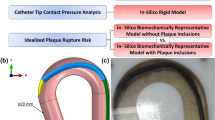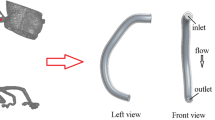Abstract
Stent-graft implantation is an important means of clinical treatment for aortic dissecting aneurysm (ADA). However, researches on fluid dynamics effects of stent were rare. Computer simulation was used to investigate the interactions between bloodstream and vascular structure in a stented ADA, which endures the periodic pulse velocity and pressure. We obtained and analyzed the flow velocity distribution, the wall displacement and wall stress in the ADA. By comparing the different results between a non-stented and a stented ADA, we found that the insertion of a vascular graft can make the location of maximum stress and displacement move from the aneurysm lumen wall to the artery wall, accompanied with a greatly decrease in value. These results imply that the placement of a stent-graft of any kind to occlude ADA will result in a decreased chance of rupture.
Similar content being viewed by others
References
Duncan, J.M., Cooley, D.A.: Aortic aneurysms. Acute Care 13, 74–96 (1987)
Crisler, C., Bahnson, H.T.: Aneurysms of the aorta. Curr. Probl. Surg. 12, 1–64 (1972)
Li, Z., Kleinstreuer, C.: Analysis of biomechanical factors affecting stent-graft migration in an AAA model. J. Biomech. 39, 2264–2273 (2006)
Bickerstaff, L.K., Pairolero, P.C., Hollier, L.H., et al.: Thoracic aortic aneurysms: A population based study. Surgery 92, 1103–1108 (1982)
Pressler, V., McNamara, J.J.: Aneurysm of the thoracic aorta. J. Thorac. Cardiovasc. Surg. 89, 50–54 (1985)
Pressler, V., McNamara, J.J.: Thoracic aortic aneurysm: natural history and treatment. J. Thorc. Cardiovasc. Surg. 79, 489–498 (1980)
Sorenson, H.R., Olsen, H.: Ruptured and dissecting aneurysms of the aorta: Incidence and prospects of surgery. Acta. Chir. Scand. 128, 644–650 (1964)
Pate, J.W., Richardson, R.J., Eastridge, C.E.: Acute aortic dissections. Ann. Surg. 42, 395–404 (1976)
Fukushima, T., Matsuzawa, T., Homma, T.: Visualization and finite element analysis of pulsatile flow in models of the AAA. Biorheology 24, 109–130 (1989)
Egelhoff, C.J., Budwig, R.S., Elger, D.F., et al.: A model study of pulsatile flow regimens in AAAs. In: Proceedings of ASME FEDSM97-34-31, ASME Fluids Engineering Division Summer Division Meeting, Vancouver, Canada (1997)
Budwig, R., Elger, D., Hooper, H., et al.: Steady flow in AAA models. ASME Journal of Biomechanical Engineering 115, 418–423 (1993)
Asbury, C.L., Ruberti, J.W., Bluth, E.I., et al.: Experimental investigations of steady flow in rigid models of AAAs. Journal of Biomedical Engineering 23, 29–39 (1995)
Bluestein, D., Niu, L., Schoephoerster, R.T., et al.: Steady flow in an aneurysm model: correlation between fluid dynamics and blood platelet deposition. SME Journal of Biomechanical Engineering 118, 280–286 (1996)
Yu, S.C.M., Chan, W.K., Ng, B.T.H., et al.: A numerical investigation on the steady and pulsatile flow characteristics in axi-symmetric AAA models with some experimental evaluation. Journal of Medical Engineering & Technology 23, 228–239 (1999)
Di Martino, E.S., Guadagni, G.: Fluid-structure interaction within realistic three-dimensional models of the aneurysmatic aorta as a guidance to assess the risk of rupture of the aneurysm. Medical Engineering & Physics 23, 647–655 (2001)
Parodi, J.C., Plahnaz, J.C., Barone, H.D.: Transfemoral intraluminal gran implantation for AAAs. Ann. Vase. Surg. 5, 437–439 (1991)
Dake, M.D., Miller, D.C., Semba, C.P., et al.: Transluminal placement of endovascular stentgraft for the treatment of descending thoracic aortic aneurysms. N. Engl. J. Med. 300, 1729–1734 (1994)
Dake, M.D., Miller, D.C., Mitchell, R.S., et al.: The first generation of endovascular stent-grafts for patients with descending thoracic aortic aneurysms. J. Thorac. Cardiovasc. Surg. 116, 689–704 (1998)
Zhang, X.W., Yao, Z.H., Zhang, Y.: Experimental and computational studies on the flow fields in aortic aneurysms associated with deployment of AAA stent-grafts. Acta Mechanica Sinica 23, 495–501 (2007)
Borghi, A., Wood, N.B., Mohiaddin, R.H., et al.: Fluid-solid interaction simulation of flow and stress pattern in thoracoadominal aneurysms: A patient-specific study. Journal of Fluids and Structures 24, 270–280 (2008)
Chaer, R.A., DeRubertis, B.G., Hynecek, R., et al.: Models of AAA: Characterization and clinical applications. Vascular 14, 343–352 (2006)
Thurbrikar, M., Al-Soudi, J., Robicsek, F.: Wall stress studies of aortic aneuysm abdominal in a clinical model. Ann. Vasc. Surg. 3, 355–366 (2001)
Meter, O.: Numerical simulation and experimental validation of blood flow in arteies with structured-tree outflow conditions. Ann. Biomed. Eng. 28, 94–98 (2000)
Fung, Y.C.: Biomechanics: Circulation, 2nd edn. Springer, New York (1997)
Liu, X., Fan, Y., Deng, X., et al.: Effect of non-Newtonian and pulsatile blood flow on mass transport in the human aorta. Journal of Biomechanics 44, 1123–1131 (2011)
Liu, X., Pu, F., Fan, Y., et al.: A numerical study on the flow of blood and the transport of LDL in the human aorta: The physiological significance of the helical flow in the aortic arch. Am. J. Physiol. Heart Circ. Physiol. 297, 163–170 (2009)
Liu, X., Fan, Y., Deng, X.: Effect of spiral flow on the transport of oxygen in the aorta: A numerical study. Annals of Biomedical Engineering 38, 917–926 (2010)
Perktold, K., Peter, R., Resch, M.: Pulsatile non-Newtonian blood flow simulation through a bifurcation with an aneurysm. Biorheology 26, 1011–1030 (1989)
Chen, Z., Fan, Y., Deng, X., et al.: Swirling flow can suppress flow disturbances in endovascular stents: A numerical study. ASAIO J. 55, 543–549 (2009)
Vorp, D.A., Raghavan, M.L., Webster, M.W.: Mechanical wall stress in aortic aneuysm abdominal: Influence of diameter and asymmetry. J. Vasc. Surg. 27, 632–639 (1998)
Li, Z.H., Kleinstreuer, C.: Fluid-structure interaction effects on sac-blood pressure and wall stress in a stented aneurysm. Journal of Biomechanical Engineering 127, 662–671 (2005)
Li, Z.H., Kleinstreuer, C.: Blood flow and structure interactions in a stented AAA model. Medical Engineering and Physics 27, 369–382 (2005)
Chen, Z., Fan, Y., Deng, X., et al.: A new way to reduce flow disturbance in endovascular stents: A numerical study. Artif. Organs. 35, 392–397 (2011)
Raghavan, M.L., Vorp, D.A.: Toward a biomechanical tool to evaluate rupure potential of aortic aneuysm abdominal: Indentification of a finite strain constitutive model and evaluation of its applicability. J. Biomech. 33, 475–482 (2000)
Wang, X., Li, X.: Fluid-structure interaction based study on the physiological factors affecting the behaviors of stented and non-stented thoracic aortic aneurysms. J. Biomech. 44, 2177–2184 (2011)
Author information
Authors and Affiliations
Corresponding author
Additional information
The project was supported by the National Natural Science Foundation of China (11172156 and 30970822) and the National Science Foundation for Post-doctoral Scientists of China (2012M510021).
Rights and permissions
About this article
Cite this article
Chen, ZS., Fan, ZM. & Zhang, XW. The interactions between bloodstream and vascular structure on aortic dissecting aneurysmal model: A numerical study. Acta Mech Sin 29, 462–468 (2013). https://doi.org/10.1007/s10409-013-0026-1
Received:
Revised:
Accepted:
Published:
Issue Date:
DOI: https://doi.org/10.1007/s10409-013-0026-1




